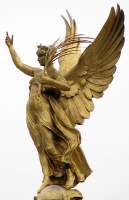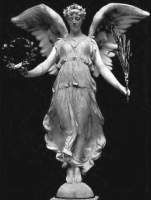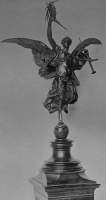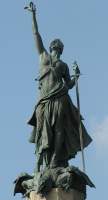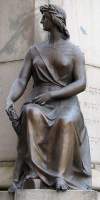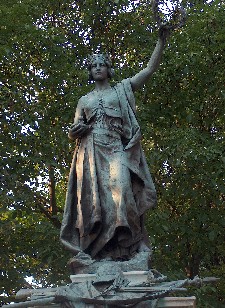V is for Victory
Victory Figure on Victoria Memorial by Brock.
Allegorical statues of Victory are widespread in Victorian and Edwardian sculpture. We find her - and it is almost invariably a her - on war memorials, or associated with great statesmen, or as ideal figures of the concept unassociated with any event or person in particular. The most iconic figure of Victory is the summit figure on Brock's Victoria Memorial in front of Buckingham Palace, high up and gilt. She can be seen from much further than the figure of the Queen herself, and looks particularly excellent when seen from half way along St James Park, glinting in bright sunlight. She carries a long palm frond, and such a frond or sprig or wreath are commonly held by Victory figures.
Two more Winged Victories are shown below. To the left is a rather nice symmetrically posed Victory, carrying both a wreath and a frond, and the position of her feet shows she has just alighted on the globe beneath her - this is a not uncommon pose, suggesting Victory on the point of arrival, as it were. She wears a crown, and this, or a wreath in her hair, as in the Victoria memorial, is also common. The figure to the right is also just landing, and carries as well as her leafy branch, a trumpet, another symbol of Victory, or the heralding of Victory.
Winged Victory figures.
Many allegorical figures of Victory are not winged, though. The one below, part of the War Memorial in Exeter, is a particularly excellent work by John Angel, not a familiar figure in England, but an important one in America, where he emigrated and made a successful career. Depicting Victory in War, she carries a sword, which is now held downwards, with a sprig of olive leaves held aloft to signify Victory in Peace. The upheld arm is a familiar part of the pose of our statues of Victory. The discerning reader will have noted that most of our figures of Victory wear light, even diaphanous clothing on the upper body, itself emblematic, hinting at the life and fruitfulness which follows Victory. As an aside we note that the Exeter Victory stands on a defeated dragon, a most scaly malevolent example of the breed (lots of other dragon sculpture on this page), its face modelled on some monitor lizard or the open gape of a Moray eel.
The Victory on the Exeter War Memorial, Northernhay Gardens.
Some variations on the theme are below. Firstly, a rather militaristic figure of Victory (though her sword bears a wreath, emblematic of Peace) wearing an Athena-style helmet, and with a Valkyrie-like physique (more examples of this physical type are on the Warrior Women page). Then a more relaxed figure, her hand holding a sprig aloft, rather than straining upwards as in the Exeter figure, and with her sword bound up now that Victory is achieved. Then a softer semi-draped Victory of Peace, by A. C. Lucchesi, a master of the undraped female figure; her sword is held only loosely in one hand, while the other is about to release a dove held to her breast. And to the far right, a nude Victory, standing on a pedestal, holding aloft a long halberd with a cuirass on it almost like a flag; a novel rendering of the subject.
Below is a cool, Classical Victory figure, simply draped, holding a wreath, and with a circlet of laurel leaves in her hair. She is seated rather than standing aloft a globe or pedestal, and in relaxed pose. There is however a feeling of strength in this figure, with her powerful upper arms and shoulders, strong columnar neck and stern gaze. This superior, understated figure is the work of Matthew Noble, and is one of the supporting allegorical statues on the Wellington Monument in Manchester.
Victory figure on the Wellington Monument in Manchester.
Finally, one of my personal favourites among Victory figures. She is the figure on the Islington Boer War Memorial (Islington page here), by the estimable Bertram Mackennal. She holds aloft her Victory wreath, and in her other hand, a lamp for the eternal flame, and beneath her feet are the helmet, sword, rifle and other weapons of the fallen whose efforts made Victory possible.
Victory, Islington Boer War Memorial.
Back to Allegorical sculpture - U // Onward to Allegorical sculpture - W // Full Alphabet of Allegorical Sculpture
Sculpture in England // Sculptors
Visits to this page from 13 Mar 2014: 18,178
